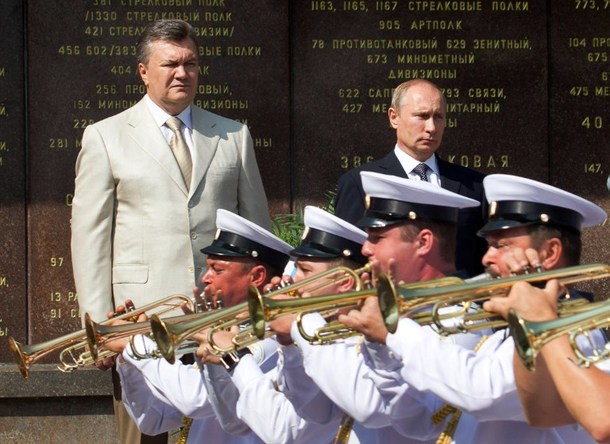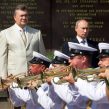
Ukrainian-Russian Relations: Facing Cool Winter
Publication: Eurasia Daily Monitor Volume: 10 Issue: 141
By:

On July 28, Vladimir Putin completed a working visit to Kyiv that immediately caused controversy about the outlook of Ukrainian-Russian relations. The Russian president had a brief meeting with his Ukrainian counterpart, Viktor Yanukovych, on July 27 while attending the official celebration of the 1025th anniversary of Kyivan Rus’ Baptism together with the presidents of Moldova and Serbia. On Sunday, Putin and Yanukovych presided over the parade for the Russian and Ukrainian Navy Day in Sevastopol. Prior to the visit, on July 24, the Kremlin announced that Putin and Yanukovych would discuss trade and economic cooperation and exchange opinions on “integration cooperation in the Eurasian space” (https://rian.com.ua/CIS_news/20130724/338072193.html).
Putin’s visit left the impression that Ukrainian-Russian relations will remain stagnant. It also raised questions about whether such stagnation might lead to a future crisis in relations between the two countries. In fact, on July 29, the Russian sanitation authority Rospotrebnadzor banned imports from the Ukrainian confectionary producer Roshen, whose key shareholder is Petro Poroshenko, a likely Kyiv mayoral and presidential candidate. Poroshenko is known as an avid supporter of Ukraine’s Association Agreement with the European Union (https://en.interfax.com.ua/news/economic/162235.html).
Moskovsky Komsomolets called Putin’s Ukrainian visit “Rus’ second baptism” (https://www.mk.ru/politics/article/2013/07/28/890688). The Russian leader’s public statements sought to persuade that spiritual values make Ukrainians, Russians and Belarusians a “single people” (https://eng.kremlin.ru/transcripts/5783), hence implying that Ukraine’s strategic choice lies with the Eurasian and not the European integration project. However, Yanukovych’s administration evidently presented an alternative scenario, in which Kyiv was assuming a leadership role in bringing not only Ukraine, but also Russia and Belarus closer to Europe.
Speaking to Jamestown on July 26, parliamentarian Volodymyr Kurennoy (UDAR party), a member of the Verkhovna Rada Foreign Affairs Committee, commented that Yanukovych arranged the Baptism celebrations because he “sensed the Kremlin’s longing for symbolism. The purpose of the festivities was to soften Russia’s reaction to Ukraine’s future signing of the Association Agreement with the EU.” Kurennoy thinks there is a “common-sense” chance that President Yanukovych will secure the EU Association Agreement in November 2013 as “not signing the agreement means a defeat for him in the 2015 presidential elections” (Author’s interview, July 26).
An important question, however, is whether Yanukovych’s government will be able to afford the rejection of the planned, Russian-led Eurasian Union. Ukraine’s economy has yet to recover from a double-dip recession. In the first six months of 2013, industrial output declined 5.3 percent year on year (ukrstat.gov.ua), and Ukraine’s fiscal deficit is on the rise. Putin presented his vision for Ukraine’s regional economic integration on July 27 while speaking at a round table sponsored by his Ukrainian supporter Viktor Medvedchuk’s “The Ukrainian Choice” organization. The Russian president stated, “Competition on the global markets is very fierce today […] only by joining forces can we be competitive and stand a chance of winning in this tough environment” (https://eng.kremlin.ru/transcripts/5783). Putin criticized the fall of bilateral trade by 18 percent in the first quarter of 2013. During this period, Ukraine cut Russian gas imports by 17 percent or $500 million (https://economics.unian.net/ukr/news/168005), equaling nearly 10 percent of Ukraine’s Russian imports from that quarter. In the first half of 2013, Ukraine further cut physical volumes of Russian gas imports by 35 percent, compared to the previous year (https://kommersant.ua/doc/2243464). At the same time, Ukraine’s exports to Russia declined by almost 14 percent year-on-year in January–May 2013, while exports to the rest of the world slid by 0.1 percent (ukrstat.gov.ua). The sharp fall in Ukraine’s exports to Russia is explained by the economic slowdown and shifting some trade growth to other regions, but also by Moscow’s import substitution policy and disruptions caused by Russian trade barriers. Furthermore, Kyiv intensively depends on Russian financing, especially in the natural gas import and transit business. Overall, this year, the government could still tap international Eurobond markets to finance Ukraine’s fiscal deficit, yet currently, the country’s economic prospects remain uncertain.
At the beginning of his Ukraine visit on July 27, Vladimir Putin proposed discussing security sector cooperation with Viktor Yanukovych (https://eng.kremlin.ru/transcripts/5789), apparently wanting to promote the integration of the two countries’ armed forces. Addressing both countries’ navies in Sevastopol on July 28, Putin said, “Today, you join the parade as a single force, symbolizing our ancestors’ strength and loyalty to their foundations. Our forebears lived for centuries together, worked together, defended their common homeland and made it strong, great and invincible… Our blood and spiritual ties are unbreakable” (https://eng.kremlin.ru/transcripts/5779). Meanwhile, Yanukovych encouraged cooperation in modernizing Russia and Ukraine’s defense sectors, including constructing new naval vessels and adopting new armaments, promising that “there is an enormous potential for expanding cooperation here” (https://en.interfax.com.ua/news/general/162260.html). Thus far, Russia has not obtained Ukraine’s consent to modernize its Black Sea Fleet, which is stationed in Sevastopol under a bilateral agreement, nor allowed Ukrainian defense manufacturers to be involved in such a naval modernization plan (see Jamestown Foundation blog, June 28). Apparently, Putin was also not happy with Kyiv’s expanding partnership cooperation with the North Atlantic Treaty Organization (NATO)—on July 5, the Ukrainian president approved a fairly broad Annual 2013 National Cooperation Program with the Alliance (https://www.president.gov.ua/documents/15898.html). Likely, Russia will continue its efforts to draw Ukraine closer to the Collective Security Treaty Organization (CSTO).
Vladimir Putin’s visit and the momentum in Ukrainian-Russian relations led Ukrainian political analyst Vadym Karasyov to conclude that Russia seeks to “create problems for Yanukovych in the presidential elections and narrow his freedom for maneuver” (https://tyzhden.ua/News/85724). This resonates with Carnegie Endowment Russia expert Dmitri Trenin’s July 12 comment that for Ukraine, “decision time will come not in November 2013 in Vilnius, but in 2015, when the country’s next presidential elections will be held. To go east, an elite decision may suffice. To go west, the public needs to be engaged” (https://carnegieeurope.eu/2013/07/12/whither-new-eastern-europe/gfc8). A survey carried out by the International Republican Institute (IRI) on May 14–28, 2013, shows that 40 percent of Ukrainian respondents preferred for Ukraine to choose an “international economic union” with the EU, while 37 percent favored the Russia-led Customs Union; 18 percent remained undecided (https://www.slideshare.net/Ratinggroup/survey-of-ukrainian-public-opinion-may-2013).
Theoretically, a split-country scenario cannot be excluded. But as of today, it does not seem very likely that Russia’s illustrative coercive economic actions or Putin’s outdated Eurasianist political philosophy will significantly alter Ukrainians’ attitudes. In the end, this adds even more uncertainty to the outlook of bilateral relations and Russian foreign policy.




